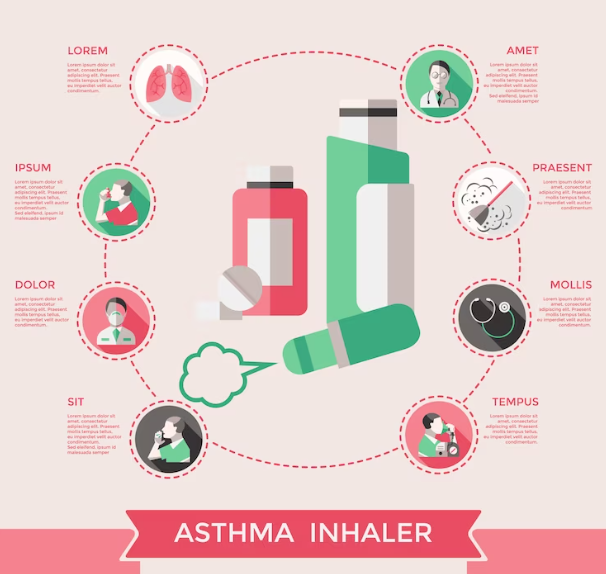Chronic Obstructive Pulmonary and Asthma Disease are long-term respiratory conditions that make it difficult for an individual to breathe. The Centers for Disease Control and Prevention estimate more than 25 million people in the United States had Asthma as of 2019, including 5 million children under 18 years. Although neither ailment has a cure, there are treatments available. Inhaling medication into the airways directly with a nebulizer or a portable inhaler is the most popular form of therapy. These medicines help to diminish inflammation, clear any mucus build-up in the lungs and open up the airways. Some of the most ordinary inhaler types for COPD and Asthma include Beta-agonists, Corticosteroids, combination inhalers and Anticholinergics.
Types of Inhalers
Most types of inhalers are small enough to fit in a purse or pocket. This includes dry powder inhalers (DPI), metered-dose inhalers (MDI) and soft mist inhalers (SMI). The basic operation of each type of handheld inhaler is the same. They deliver medication through inhalation. To use an inhaler, an individual closes their mouth around the mouthpiece and inhales the drug from the canister. However, there are a few differences. For example:
- MDI carries medicine in Aerosol form. The user must press the canister, to ignite the propellant and breathe in at the same time.
- DPI transfers medication without a propellant. The individual inhales the medicine into their lungs with their inward breath.
- SMI is related to DPI as the individual uses their inward breath to inhale the medicine. However, SMIs have more particles than MIDs and DPI and the drug enters the lungs more gradually, allowing the patient to inhale more medication.
Each kind of inhaler has benefits and drawbacks and the amount of medication that enters a user’s lungs determines how effective the device is. Dr. Sheetu Singh consider a person’s attribute or features to determine which inhaler is best, including:
- Cognitive status
- Age
- Ability to coordinate inhalation with activation of the canister
- Manual dexterity
However, while managing Asthma in children under the age of 5, Dr. Sheetu Singh typically prescribes a valved holding chamber with a mask. The mask allows the kid to take diverse breaths to get the same amount of medication and drugs as breathing in one large puff. They may also recommend a nebulizer for young toddlers.
Nebulizers
Nebulizers are different types of inhaler devices that involve breathing through a mask. They consist of a container of liquid medicine, an air compressor and a tube that connects the two. A person uses a mask or a mouthpiece above the medicine container to inhale the mist. Nebulizers are available in electric versions and battery-powered. While they are larger than handheld inhalers, such as young children, they are perfect for those who might not be able to utilize an inhaler successfully.
Inhalers for Asthma
When an individual has an Asthma attack, the airways in their lungs become narrow and inflamed and produce mucus which restricts the air supply. To treat chronic asthma symptoms and to relieve asthma attacks, asthma inhalers administer medication to the lungs. The medication in these inhaler types depends on a person’s needs and requirements.
Corticosteroids
Inflammation in the airway is reduced by Corticosteroids, which also prevent Asthma attacks. These medications are long-term and controllers. The goal of controller asthma medication is to prevent the progression of asthma symptoms by gradually lowering airway inflammation. Common types of corticosteroids include:
- Budesonide (Pulmicort Flexhaler)
- Beclomethasone (Qvar)
- Fluticasone (Flovent Diskus, Flovent HFA, Arnuity Ellipta)
- Ciclesonide (Alvesco)
- Mometasone (Asmanex)
Long-acting Beta-agonists
LABA facilitates better breathing by relaxing the muscles that surround the airways of the lungs and maintaining their openness. The common combination inhalers include:
- Budesonide and Formoterol (Symbicort)
- Fluticasone and Salmeterol (Advair Diskus, Advair HFA)
- Fluticasone and Vilanterol (Breo Ellipta)
- Mometasone and Formoterol (Dulera)
Anticholinergics
Another sort of long-term controller medication is Anticholinergics. They assist in diminishing mucus production, widen the airways and relax the lung muscles. Tiotropium Bromide is an asthma controller medicine that Dr. Sheetu Singh is often prescribed with other controller therapies.
Short-acting Beta-agonists
Quick-acting beta-agonists or short-acting beta-agonists are rescue and quick-relief medicines. They work to open the airway and relieve symptoms quickly during an asthma flare-up. Common short-acting beta-agonists include:
- Levalbuterol (Xopenex HFA)
- Albuterol (ProAir HFA, Ventolin HFA)
- Pirbuterol (Maxair Autohaler)
Inhalers for COPD
COPD refers to multiple respiratory conditions that affect an individual’s ability to breathe including Emphysema, Chronic Bronchitis and Asthma. People with COPD disease might use inhaler devices to deliver medicine directly into their airways. COPD inhalers include quick-relief and rescue medications and long-term and controller medicines.
Corticosteroids
The common inhaled corticosteroids for COPD include:-
- Fluticasone (Flovent)
- Beclomethasone (Qvar)
- Mometasone (Asmanex)
- Ciclesonide (Alvesco)
- Flunisolide (Aerobid)
- Budesonide (pulmicort)
Beta-agonist inhaler types
The most popular inhaled beta-agonists, which last anywhere from 6 to 12 hours, are LABAs. These include:
- Formoterol (Foradil; Perforomist)
- Arformoterol (Brovana)
- Salmeterol (Serevant)
Anticholinergics
Inhaled Anticholinergics for COPD include:
- Glycopyrronium (Seebri Neohaler)
- Aclidinium (Tudorza Pressair)
- Tiotropium (Spiriva)
- Ipratropium (Atrovent)
- Umeclidinium (Incruse Ellipta)
Quick-acting Beta-agonists
Bronchodilators or short or quick-acting beta-agonists offer fast relief when a person has symptoms of a COPD flare-up such as coughing, wheezing and difficulty in breathing. Common bronchodilators include:
- Levalbuterol (Xopenex HFA)
- Albuterol (ProAir HFA, Proventil HFA, Ventolin HFA)
- Albuterol and Ipratropium (Combivent)
Quick-acting beta-agonists usually come in an MDI inhaler, however a patient may occasionally utilize a nebulizer. These medications could have negative effects like:
- Anxiety
- Headache
- Tremor
- Restlessness
- Irregular or increased heartbeats.


